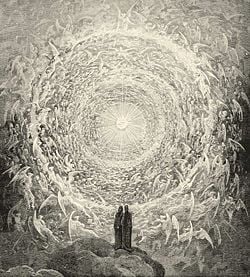|
|
| (One intermediate revision by the same user not shown) |
| Line 1: |
Line 1: |
| | {{Main page article box| | | {{Main page article box| |
| | type=Featured| | | type=Featured| |
| − | title=Cuneiform script| | + | title=Afterlife| |
| − | image_name=Sumerian 26th c Adab.jpg| | + | image_name=Paradiso Canto 31.jpg| |
| − | image_desc=Sumerian inscription in monumental archaic style, c. twenty-sixth century B.C.E.| | + | image_desc=[[Paradise]]—[[Dante]] and Beatrice gaze upon the highest Heaven (The Empyrean), by Gustave Doré| |
| − | text=The '''cuneiform script''' (kjuːˈniːəfɔrm) is the earliest known form of [[writing|written expression]]. As such, those writings that remain are [[communication]]s from peoples long gone from the earth. Created by the [[Sumer]]ians in approximately 3000 B.C.E., cuneiform writing began as a system of [[pictograph]]s. Over time, the pictorial representations became simplified and more abstract. Cuneiforms were inscribed on [[clay tablet]]s, on which [[symbol]]s were drawn with a blunt [[Phragmites|reed]] for a [[stylus]]. The impressions left by the stylus were wedge shaped, thus giving rise to the name cuneiform ("wedge shaped"). | + | text=The '''afterlife,''' or '''life after death,''' is a generic term referring to the continuation of [[existence]] after [[death]], typically [[spirituality|spiritual]], experiential, or [[ghost]]-like, beyond this world. This afterlife is an existence which stretches on to [[eternity]], compared to the short span of life on earth. Most believers have a optimistic view of the afterlife, believing that they will enjoy a pleasurable existence with friends and loved ones in [[heaven]]. Many also believe in a place of punishment called [[hell]], although they do not believe they will live there. |
| − | | + | }} |
| − | The Sumerian script was adapted for the writing of the [[Akkadian language|Akkadian]], [[Elamite language|Elamite]], [[Hittite language|Hittite]] (and [[Luwian language|Luwian]]), [[Hurrian language|Hurrian]] (and [[Urartian language|Urartian]]) languages, and it inspired the [[Old Persian cuneiform script|Old Persian]] and [[Ugaritic alphabet|Ugaritic]] national [[alphabet]]s. Although it then disappeared when these cultures faded and new scripts, such as the [[Phoenician alphabet]] developed, numerous clay tablets, [[stela]]e (such as those upon which the [[Code of Hammurabi]] is written), and even the sides of cliffs (such as those containing the [[Behistun inscription]]) with cuneiform writings remained. Discovered by [[archeology|archaeologists]] and deciphered by the efforts of a series of [[linguistics|linguists]], cuneiform inscriptions provide valuable insights into cultures of the past.}}
| |

Paradise—
Dante and Beatrice gaze upon the highest Heaven (The Empyrean), by Gustave Doré
The
afterlife, or
life after death, is a generic term referring to the continuation of
existence after
death, typically
spiritual, experiential, or ghost-like, beyond this world. This afterlife is an existence which stretches on to eternity, compared to the short span of life on earth. Most believers have a optimistic view of the afterlife, believing that they will enjoy a pleasurable existence with friends and loved ones in
heaven. Many also believe in a place of punishment called
hell, although they do not believe they will live there.
